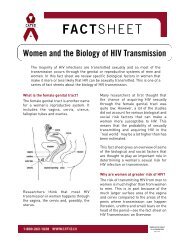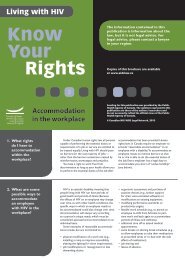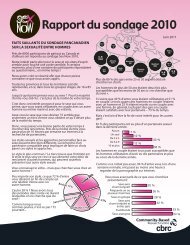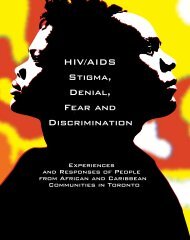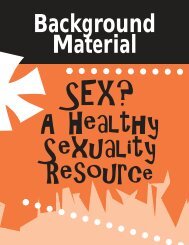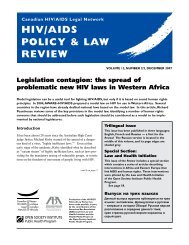TARGETSFor individualsBy 2010:• The proportion of people with HIV living inpoverty drops.• The proportion of people living with HIVdependent on food banks drops.• The proportion of people living withHIV who have affordable, appropriatehousing increases.• The proportion of people living with HIVwho report that they have strong socialsupport networks increases.• The proportion of people living withHIV who report that they have access toflexible employment opportunities thataccommodate HIV increases.• The proportion of people living with HIVwho have untreated depression drops.• The number of reports of incidents ofstigma and discrimination in housing,employment, health care settings or othersituations drops.• The proportion of people with HIVwho report feeling stigmatized by theirillness drops.• Gay men, Aboriginal people and peoplefrom countries where HIV is endemicwho are living with HIV receive moresupport within their own ethnic orcultural communities.• The proportion of Canadians who arecomfortable working with someone whohas HIV increases from 70% to 90%.• The proportion of Canadian parents whoare comfortable having their childrenattend school with a student who has HIVincreases from 57% to 80%.For organizations and communitiesBy 2010:• Organizations develop programs to reducethe social inequities driving the epidemic.• Communities at risk (e.g., people who useinjection drugs, Aboriginal people, peoplefrom countries where HIV is endemic, peoplein correctional facilities) report measurableimprovements in their access to appropriate,comprehensive health and social services,including housing, income and healthpromotion/harm reduction programs.• Organizations that provide services topeople with HIV and communities at riskreceive support in reducing HIV-relatedstigma and discrimination experienced bytheir communities.• Communities at risk develop and implementstrategies to increase social support fortheir members living with HIV.For governmentsBy 2010:• Governments have implemented long-termsustained plans to address HIV-relatedstigma and discrimination.• HIV/AIDS is on the agenda of intergovernmentaldiscussions about health andwell-being, particularly those focussedon inner cities.• Governments have developed concreteplans to change any policies or laws thathinder efforts to stop the epidemic.• Governments have taken significant stepsto adopt a health and human rightsapproach (as opposed to a criminal lawapproach) to drug use.• Governments create opportunities forgreater involvement of PHAs in governmentdecisions, organizations and programs.ACTIONSHuman rights2.1 Pursue collaborative initiatives – locally,provincially, territorially and federally – toraise awareness of the underlying factorsthat contribute to the epidemic and todevelop support for change.2.2 Enforce legislation, policies and othermeasures designed to protect the rights ofpeople with HIV, and use other measures,including communication and education,to make the public aware of humanrights issues.28.
2.3 Fund initiatives that have the potentialto reduce social inequities (e.g., domesticviolence initiatives, programs designed toreduce physical and sexual abuse, harmreduction programs).2.4 Provide access to legal assistance forpeople living with HIV and those at riskwho are dealing with discrimination orhuman rights violations.2.5 Create a legal and policy environmentthat supports the health of people who useinjection drugs by reviewing and, if necessary,changing current drug legislation to reflecta human rights approach, reduce the burdenon the criminal justice system and ensurethat people who use injection drugs havethe same access to health services as thosewho do not use injection drugs.2.6 Create an environment that supports thehealth of people in correctional facilities byreviewing and, if necessary, changing anypolicies that have a negative impact onthe health of prisoners and their access toHIV-related services that would be availableto them in the community.2.7 Create an environment that supports thehealth of sex workers by reviewing and, ifnecessary, changing any local, provincial,territorial and federal policies and lawsthat have a negative impact on the healthof sex workers.2.8 Review other laws, policies and practicesin the public and private sector, and changeany that create barriers to HIV prevention,diagnosis, care, treatment and support.Income security, housing and employment2.9 Develop baseline data on the socialdeterminants of health (e.g., the numberof people with HIV experiencing problemswith poverty, food security, housing,social support, employment, depression,discrimination).2.10 Review and, if necessary, change socialassistance policies and practices – andinsurance laws, policies and practices – toprovide people living with HIV and individualsat risk with greater income security.2.11 Review and , if necessary, change housingpolicies and practices – municipally, provincially,territorially and federally – to givepeople living with HIV and communities atrisk better access to affordable, appropriatehousing.2.12 Review and, if necessary, change employmentlaws, policies and practices to giveall people living with long-term debilitatingillnesses greater access to employmentopportunities that can accommodatetheir disability.Stigma and discrimination2.13 Implement communication/educationinitiatives, including age-appropriateeducation programs for children and youth,designed to fight all types of discrimination(e.g., racism, homophobia, sexism), violenceand abuse.2.14 Implement education programs designedto change negative public attitudes towardpeople who use injection drugs and makepeople more receptive to harm reductioninitiatives in their communities.2.15 Enhance capacity at all levels – federal,provincial, territorial and local – to respondimmediately to HIV-related discrimination.2.16 Implement programs to address HIVrelatedstigma and discrimination that givepeople opportunities for one-to-one contactwith people living with HIV.2.17 Create an environment within the gaycommunity, Aboriginal communities andethnocultural and ethnoracial communitiesthat affirms members who are living withHIV and their place in the community.Research/monitoring2.18 Conduct regular surveys of people livingwith HIV and communities at risk to assesstheir access to income, housing, employmentand social support, and their experiencewith stigma and discrimination, with dataon vulnerable populations collected in waysthat respect their right to confidentialityand privacy.2.19 Develop a better understanding of therelationships between knowledge, personalcontact and social distance to inform programsto reduce stigma and discrimination.<strong>leadingtogether</strong>29.



